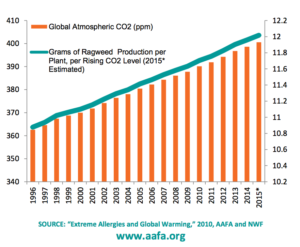Now, thanks to climate change and increasing carbon dioxide levels, each year’s pollen season gets worse.
According to a 2014 report by the National Climate Assessment, longer growing seasons, along with higher temperatures and carbon dioxide levels, can increase pollen production, intensifying and lengthening the allergy season.
Scientific American’s podcast Science Talk discusses how allergies are on the rise, possibly because of what’s called the hygiene hypothesis. As people start living in more sterile and urban environments, their immune systems aren’t exposed to microbes and don’t know what to do when they encounter allergens or bacteria, making allergies and autoimmune diseases more prevalent.
But it seems the hygiene hypothesis can’t explain everything about the increase in pollen allergies. Researchers found that specific sensitivity to ragweed pollen, which up to 20 % of Americans are allergic to, increased by 15% over a four year period.

As you can see in the graph, pollen levels have been getting worse each year across the globe for at least the last 20 years, as carbon dioxide levels rise.

